The Rosette Nebula (also known as Caldwell 49) is an H II region located near one end of a giant molecular cloud in the Milky Way Galaxy’s Monoceros region. The open cluster NGC 2244 (Caldwell 50) is closely related to nebulosity, with the stars of the cluster formed from nebula matter. The nebula has been described as having the shape of a human skull and is sometimes referred to as the “Skull Nebula.” It is not to be confused with NGC 246, also known as the “Skull Nebula.”
The Rosette Nebula is a large, circular-shaped emission nebula located about 5,200 light-years from Earth in the constellation Monoceros. The nebula’s rose-like shape is caused by the interaction of ionized hydrogen gas in the nebula with ultraviolet radiation from nearby hot stars. It is about 130 light-years across and contains several open clusters of young stars, including NGC 2244 at its center. This cluster is responsible for ionizing the nebula’s gas and producing its distinctive pinkish-red glow.
The cluster and nebula are located 5,000 light-years from Earth and have a diameter of about 130 light-years. The radiation from the young stars excites the atoms in the nebula, causing them to emit their own radiation, resulting in the emission nebula we see. The nebula’s mass is estimated to be around 10,000 solar masses.

The presence of numerous newborn stars inside the optical Rosette Nebula and studded within a dense molecular cloud was discovered during a survey of the nebula with the Chandra X-ray Observatory. This star-forming complex contains approximately 2500 young stars, including the massive O-type stars HD 46223 and HD 46150, which are primarily responsible for blowing the ionized bubble. Most of the ongoing star-formation activity is occurring in the dense molecular cloud to the southeast of the bubble.
The Rosette Nebula is a popular target for amateur astronomers, as it can be seen with binoculars or small telescopes under dark skies. It was first discovered by the French astronomer Édouard Jean-Marie Stephan in 1868.
















